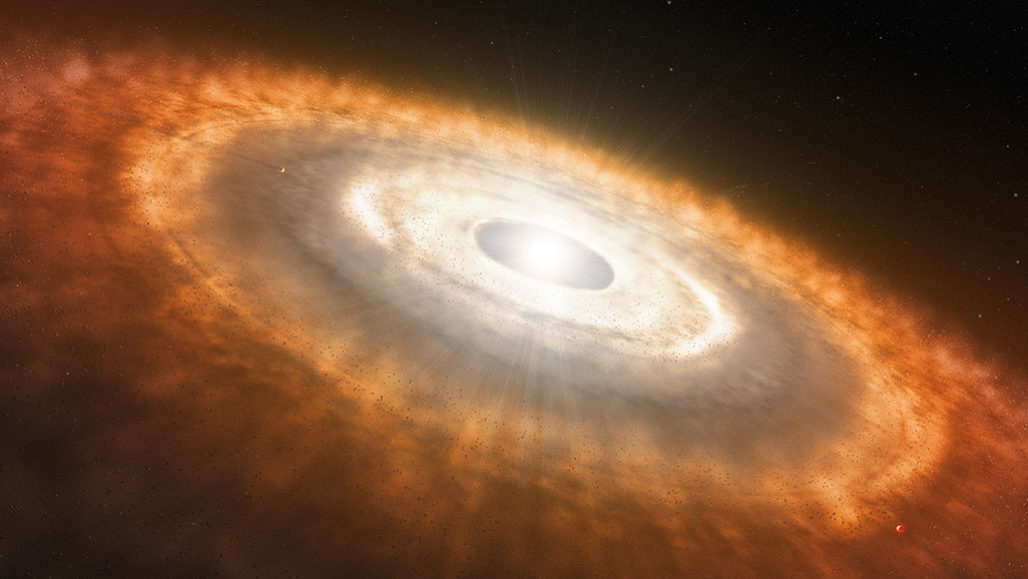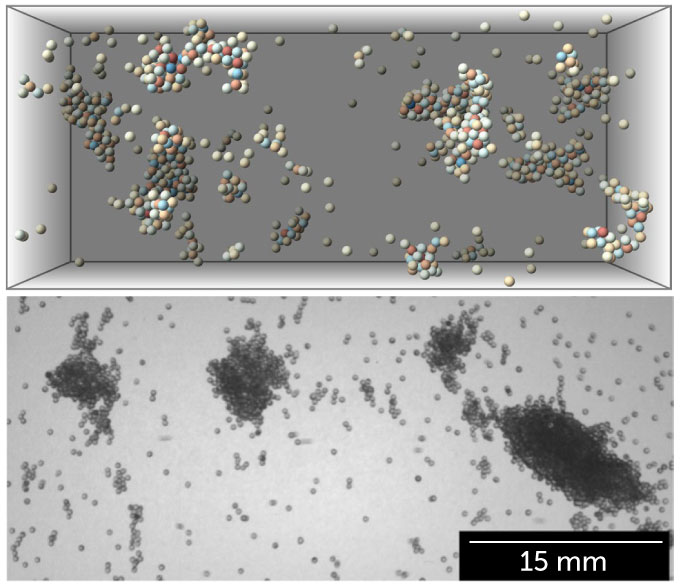Glass beads help scientists puzzle out how baby planets grow
Their experiments suggest electric charges let space-dust grains clump into planets

Planets develop when dust particles clump together. They do this in what is known as a protoplanetary disk (illustrated) around some young star. Electric charges may build up on the particles, causing them to clump.
L. Calçada/ESO
Growing up is hard to do. It’s especially hard for baby planets.
There’s an obstacle to planet-forming. Known as the bouncing barrier, it hinders the clumping of dust needed to form planets. But giving those dust grains an electric charge would seem to help, new lab tests show. That charge provides an extra stickiness, the scientists reported December 9 in Nature Physics.
In the lab, the scientists vigorously shook thousands of small glass beads. Then, the team catapulted those beads more than 100 meters (yards) skyward. It was all in an attempt to mimic conditions in the regions where planets form.
Planets are born in pancakes of dust and gas known as protoplanetary disks. Inside these disks, the seeds of planets collide and stick. Over time they form larger and larger clumps. But experiments and computer simulations have suggested that once particles get to be about a millimeter (four hundredths of an inch) in size, the clumping stops. Rather than sticking to each other, the mini-clumps now bounce off one another. That’s that so-called bouncing barrier. It’s an odd behavior that has foiled scientists’ attempts to simulate how planets formed.
Yet the dust particles must have overcome the bouncing barrier. If they didn’t, the cosmos wouldn’t be peppered with a wide variety of worlds. “We see exoplanets, so there must be a way to get bigger particles,” says Tobias Steinpilz. He is experimental astrophysicist at the University of Duisburg-Essen in Germany.
He and his colleagues wanted to investigate. So they set out to make analogs of planetary seeds. Instead of dust, they used glass beads. Each bead was a bit less than half a millimeter in diameter. The team wanted to watch them colliide. The smashups would mimic dust particles banging together in the protoplanetary disk. But there was one catch: Earth’s gravity. “That overpowers everything we want to see,” Steinpilz explained.

So his team launched its experiment with a catapult. They did it inside the 120-meter-tall Bremen Drop Tower in Germany. They catapulted the apparatus containing the beads upward together with a camera and other equipment. Then, they let gravity pull it all back to Earth. During the approximately nine-second freefall, everything was effectively weightless.
Prior to the launch, the researchers shook the beads. Their idea was to imitate the collisions that particles in a protoplanetary disk would experience over time. That movement caused the beads to build up electric charges. There were some negative and some positive charges. When the beads became weightless, they clumped. Some clumps had more than a thousand beads. The electric forces between the charged beads caused the clumping, Steinpilz’ team determined.
The results “clearly show that [electric charges] help [dust grains] grow beyond the bouncing barrier in lab conditions,” says Richard Booth. An astronomer at the University of Cambridge in England, he was not involved in the tests. He notes, however, that “there is a question of trying to extrapolate these lab conditions to what we see in protoplanetary disks.” For instance, the disks consist of rock dust, not glass beads.
Steinpilz’s team considered that. It also performed shaking experiments — but not the catapulting ones — using spheres of basalt. That’s a type of volcanic rock. The basalt spheres are more like what the dust grains would be in a true protoplanetary disk. The bits of basalt charged up even more than the glass beads had, the team found. That suggests the clumping effect might be even stronger in protoplanetary disks.
There are other barriers for developing planets, though. High-speed particles are one example. They can collide and break larger clumps apart.
Clearly, growing up takes a lot of grit.







